Michigan vegetable crop report - July 14, 2022
The disease and insect management season is upon us.

Weather
Watch Jeff Andresen's weather update here.
Irrigation has been a main focus for most vegetable growers. Rainfall has been relatively sparse and evapotranspiration rates have been high. On the rain front, precipitation was about 50% of normal (or less) for May 11-July 11. This deficit amounts to about a month’s worth of normal summer rainfall. Soils are most dry in the central Lower Peninsula of Michigan. Precipitation was variable over the past week, with southwest Michigan picking up heavier rains.
Degree day totals are several days behind normal in the Upper Peninsula increasing to several days ahead in the south.
The forecast calls for:
- Variably cloudy weather Wednesday with scattered showers possible, especially south and central sections.
- Mostly sunny and dry Thursday.
- Mostly fair and warmer Friday.
- Scattered showers and thundershowers possible Saturday and Sunday.
- Fair, dry, and warmer early next week.
- Precipitation for the coming week is expected to total 0.25 inch to the south, with totals decreasing to the north. Evapotranspiration rates should be closer to normal for the coming week given cooler weather.
- Daytime temperatures in the 70s to near 80 through Thursday, warming into the 80s Friday through this weekend. Lows in the 50s through Thursday warming back to the 60s this weekend.
- Medium range guidance calls for warmer than normal mean temperatures with normal to below normal precipitation totals.
Help is here: Get plugged into the new Enviroweather
Do you need help with setting up an account and dashboard on Enviroweather’s new website? You can send an email to eweather@msu.edu with the weather stations, crops and models that you are interested in, and we’ll set it up.
Crop updates
Asparagus
It’s the fern pest and disease season. Crop consultants and MSU Extension have observed rust and purple spot, especially in some younger fields, which have been shut down for some time. Old rust aeciospore lesions show evidence of past primary infection, while the repeating uredospore stage is now active. Scout for rust by checking both the main stems and branches for uredospore lesions. Prioritize scouting young fields, fields that had rust last year, or those near to other sources of rust. Consider protecting “rusty” fields but also nearby ones with tebuconazole. Three applications are allowed per season.
Purple spot lesions were also visible this week, especially in younger fields. These likely grew through the ideal purple spot weather that occurred during harvest. Chlorothalonil and mancozeb are our main purple spot tools.
Japanese beetles are a common sight on the edges of fields, common asparagus beetle larvae have been active in problem spots, and at least one grower has observed grasshoppers causing issues. So, what’s labeled? Check out the online, mobile-friendly version of our spray book, the Midwest Vegetable Production Guide, where you can filter by crop, pest, PHI, REI etc. Here’s the output for asparagus, with Japanese beetle, asparagus beetle, and tarnished plant bug selected as pests.
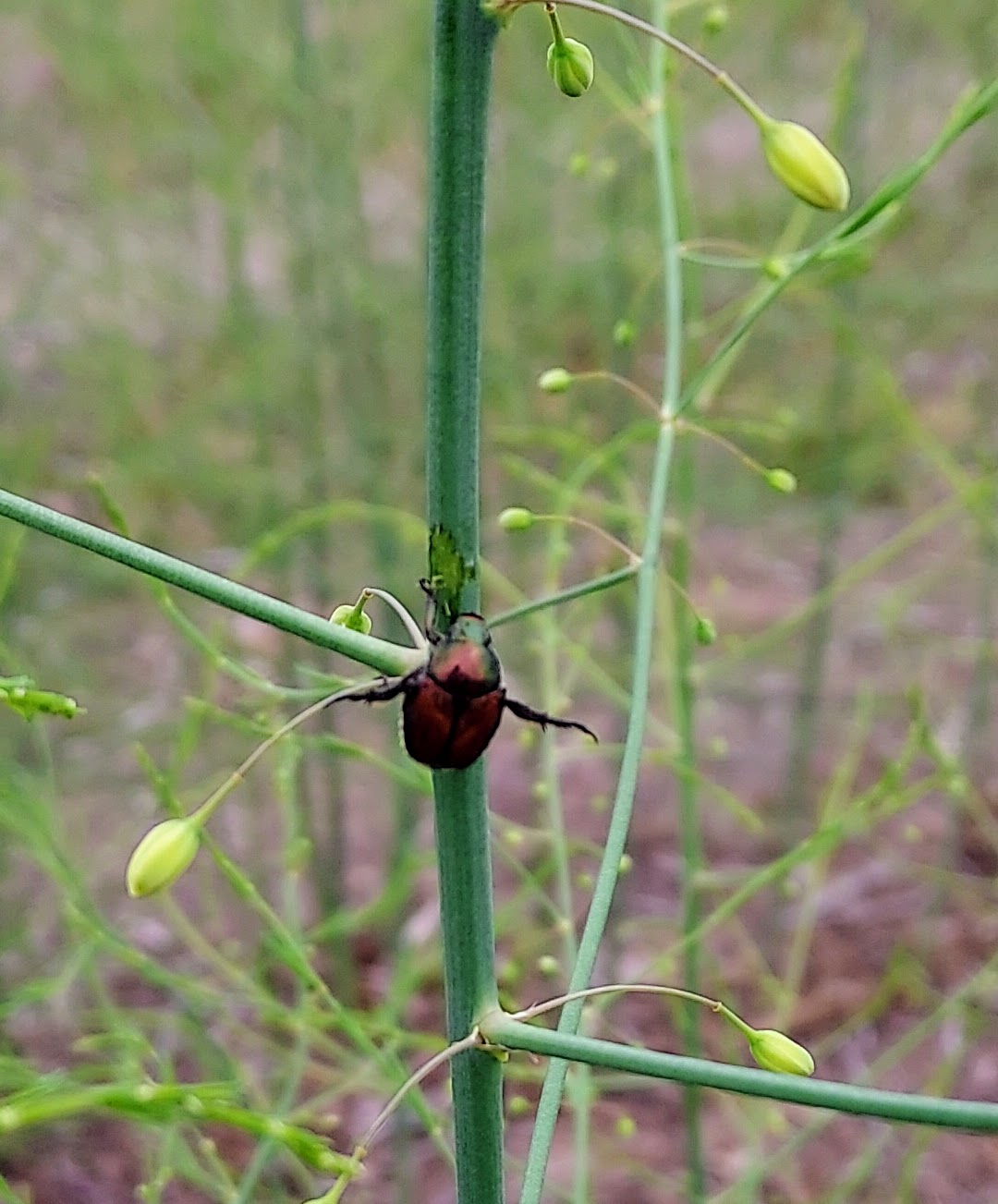
Carrots and celery
Carrot growers were making their first fungicide applications last week as consultants set out TomCast sensors. Crop consultants detected aphid colonies in celery in some fields last week for the first time. Movento - applied with a penetrating surfactant - is very effective for aphids. Movento can be applied at 4-5 fl oz/A, the minimum interval between applications is seven days and the pre-harvest interval is three days.
Aster leafhopper infectivity for aster yellows phytoplasma remains low this year, less than 1% of the leafhoppers tested so far from carrot and celery fields have tested positive for aster yellows. While leafhoppers are abundant this year, their numbers do not correlate with infectivity.

Cole crops
It has been an interesting year on the cabbage maggot front sans Lorsban! “Above-ground” cole crops (broccoli, cabbage) that survived the initial spring damage are now apparently doing just fine. The plants that died, died early, the rest are apparently growing fine.
On the root crop front, one of the main experience-based lessons this year seems to be about rotation. Early crops that were near to last year’s brassicas had the worst issues. Fields that were planted out of the heart of brassica country had less or even no issues. Of course, not all growers have access to different growing areas.
Turnips have been rolling in the past week or so, and as of early this week damage was present but growers were still getting harvestable product. Good news! (Great news?!)
Where and when will cabbage maggot be a concern now? Currently, weather models suggest the peak of the early summer flight is over, based on degree days at the Allegan, Fennville, Hudsonville and Grant Enviroweather stations. There is a third flight that typically occurs in early August in these areas. Rutabagas and late-sown turnips may be attacked by this final, late-summer flight. Leafy brassicas (except for Napa cabbage) are typically not bothered by these later generations.
Product placement may be key for cabbage maggot. This pest lays eggs right around the crown and into the soil on the base of plants. Insecticide has to kill the tiny maggots when they hatch, and before they do their dirty work underground. One way to reach this target could be to come at the plants from the side with a banded application, using drops with angled nozzles for a directed spray. Water sensitive paper could be a useful tool here; growers could place some under the canopy near the plant base, pass over it with the sprayer, and see if they are reaching the target. Comparing this to a typical broadcast boom would be even better. This would at least confirm that the “one bed at a time” directed spray is doing a better job reaching the target than less time intensive, broadcast sprays.

Cucurbits/Pickles
Cantaloupe harvest started in some areas. Squash bugs can be found now in some fields. At the Southwest Michigan Research and Extension Center, the first hatch of young nymphs has been observed and appears to be associated with wilting in zucchini. Whether adult squash bugs targeted their eggs on weak and declining plants from some other pathogen, or if they themselves have caused the wilt, remains to be diagnosed.
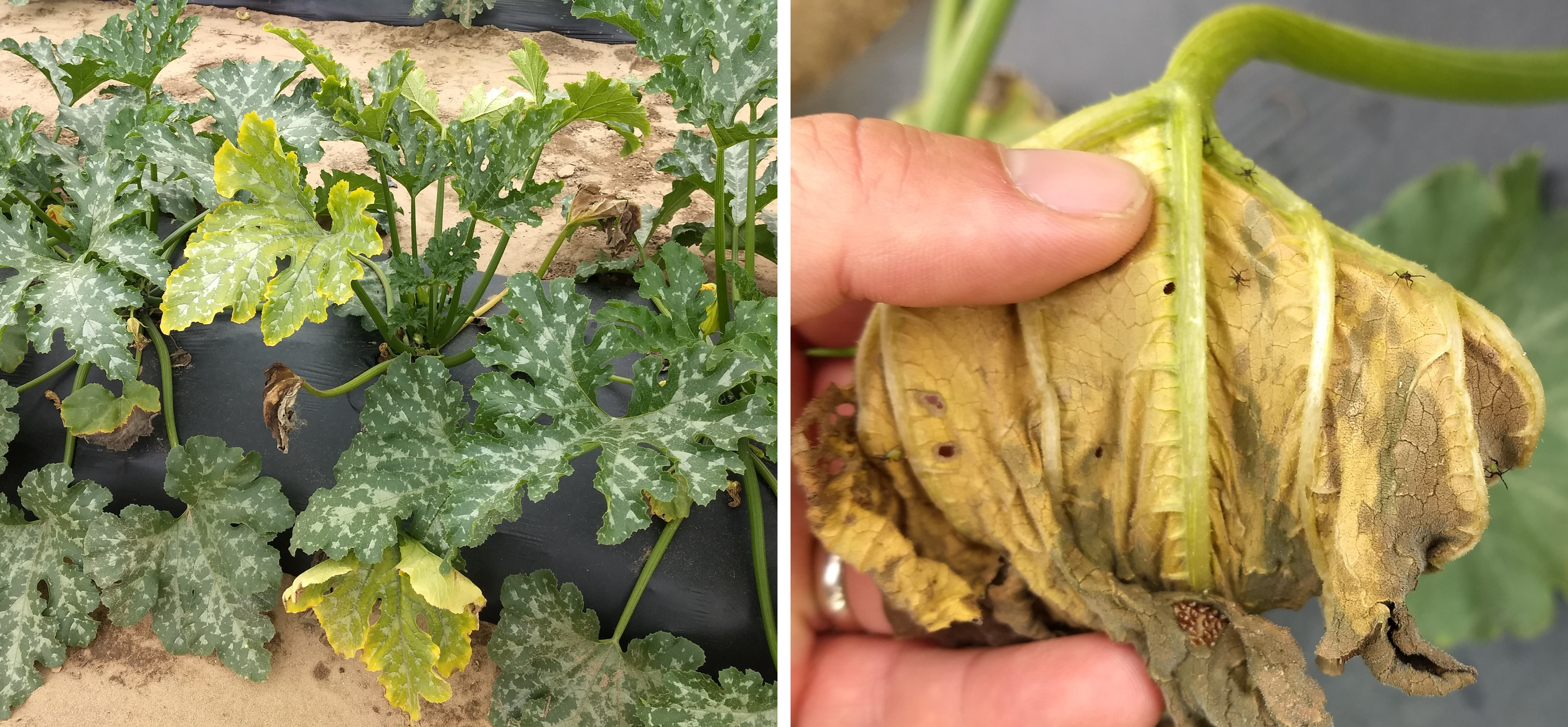
High tunnel cucumbers are reaching their end on some farms. Spider mites are a serious pest in these environments. Broad-spectrum insecticides to kill things like aphids and beetles tend to cause mite populations to flare up because the insecticides also kill the natural enemies that were keeping the mites in check. Special acaricides are a better choice for a spray solution because they target mites, which are arachnids.
Here is a list of miticides that are allowed for use in greenhouses.
Predatory mites are also an approach worth exploring to handling pest mites in greenhouses. Page 4 of this bulletin, Commercially Available Biological Control Agents for Common Greenhouse Insect Pests, details the various predators of spider mites. For some mite-on-mite action, here are some characterizations of the best options.
The industry standard predatory mite combination seems to be Amblyseius andersoni and Phytoseiulus persimilis. To use a pesticide analogy, P. persimilis has a good “knock down” effect with satisfying immediate action targeting spider mites at all life stages, including eggs. A. andersoni provides a “residual” as a long-lasting predatory mite that works best on background populations of many species of pest mites and will also sustain themselves on pollen that your crop produces, or which can be purchased and applied separately.
Jack O’ Lantern pumpkins were just starting to flower this week in some Oceana County fields. As the weeks roll by, consider that the “onset of fruit set” is an important milestone for disease management, both for powdery mildew and Phytophthora capsici. Powdery mildew onset tends to happen in the period after plants set fruit; pumpkin fruit are also an important target to protect from Phytophthora. On the Phytophthora front, check out Hausbeck’s factsheets.
Onions/Garlic
Sweet onion harvest has begun on some farms. Plasticulture onions tend to yield earlier. Grower preference for white-on-black or plain black plastic varies. Yields can be earlier and heavier with darker plastic, similar to other vegetables. But, anecdotally, the outermost bulb layer of red onions in the western-most rows on north-south planted fields have been known to “cook” on plain black plastic. Some garlic scapes and young bulbs are being harvested as well.
Keep a close eye on onion thrips populations as they continue to grow. The warm and dry conditions facilitate their development, so checking their numbers on plants is essential to determine when the correct time is to apply insecticides. Check out the recommendations for onion thrips management. Here is a video on how to scout onion thrips. Check out the Midwest Veg Guide’s list of labeled actives.
Potatoes
The summer generation of Colorado potato beetles are now emerging, so it is likely that the majority of adults you see in the field at this time are newly emerged adults. This is the time of year when growers should switch to a different type of insecticide than was used for controlling the previous generation. Insecticides with different active ingredients are listed below in the table. Check out the Midwest Guides output of actives labeled for Colorado potato beetle (always check for notes on resistance).
|
Insecticide options for summer Colorado potato beetle management |
|||
|
Delivery |
Product |
Active Ingredient |
|
|
Foliar |
Agri-Mek, generics |
abamectin |
6 |
|
Foliar |
Coragen, Voliam Xpress1 |
chlorantraniliprole |
28 |
|
Foliar |
Exirel |
cyantraniliprole |
28 |
|
Foliar |
Admire Pro, generics |
imidacloprid |
4A |
|
Foliar |
Avaunt2 |
indoxacarb |
22A |
|
Foliar |
Torac |
tolfenpyrad |
21A |
|
Foliar |
Radiant |
spinetoram |
5 |
|
Foliar |
Blackhawk, Entrust |
spinosad |
5 |
|
Foliar |
Actara, Endigo ZC1 |
thiamethoxam |
4A |
|
1 premixed with pyrethroid, apply when potato leafhoppers are also problematic 2 Avaunt has limited activity on larvae |
|||
In Michigan, early blight risk severity is high to very high in early-planted potato crops, with estimated emergence of May 1 (Figure 1). Most of the early planted crops in the lower peninsula are at very high early blight risk and protectant foliar programs have been initiated. Mid- and late-planted potato crops, with estimated emergences of May 15 or Jun 1, are predicted to be low risk throughout Michigan. Late blight risk severity is low for early- and late-planted potato crops (Figure 2). Fields that experienced scattered rain showers may be at higher risk. Preventative programs are typically initiated by row closure and fields should be monitored closely.
Early blight risk high in early-planted potatoes and late blight risk low across Michigan – July 13, 2022.
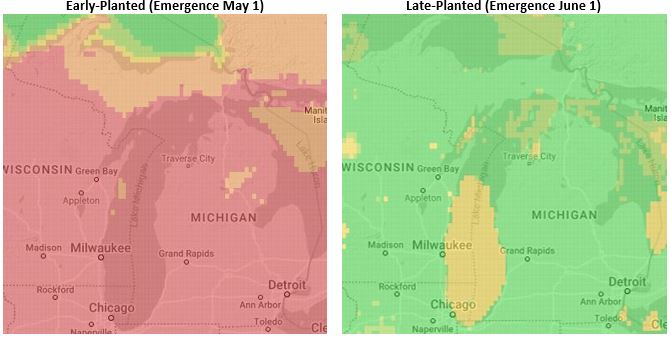
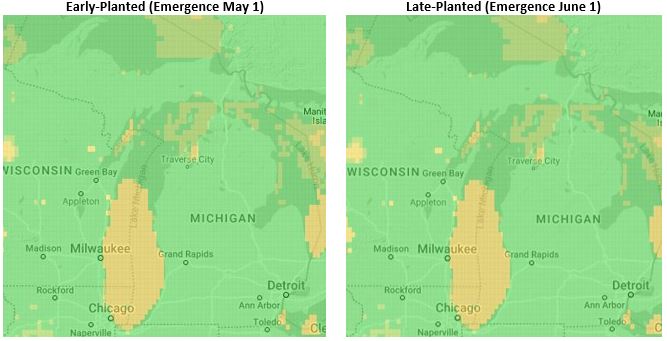
A potato sample was received by the Potato and Sugar Beet Pathology program in late June with necrotic “pepper spots” scattered moderately over the surface, and more densely and slightly sunken on the reverse side, of leaves at lower, mid, and upper canopy levels (Figure 3). On more severely affected plants, lower canopy leaves were beginning to senesce and had chlorotic and necrotic symptoms coalescing at the margins.
Symptom onset was correlated with high ozone levels (66-75 ppb) reported by the Michigan Department of Environment, Great Lakes, and Energy on June 15, 20 and 21. Ozone levels over 80 ppb for 4 or 5 consecutive hours or over 70 ppb for 1 or 2 days are sufficient to injure susceptible plants.
Affected plants may outgrow these symptoms, however, ozone injury can predispose foliage leaves to infection by other foliar pathogens such as Alternaria spp. (early blight and brown spot) and Botrytis cinerea (gray mold). Fields should be monitored closely and treated with preventative management programs. Ozone susceptibility depends on growth stage and variety. In general, studies have identified that later maturing varieties were less susceptible to ozone injury.
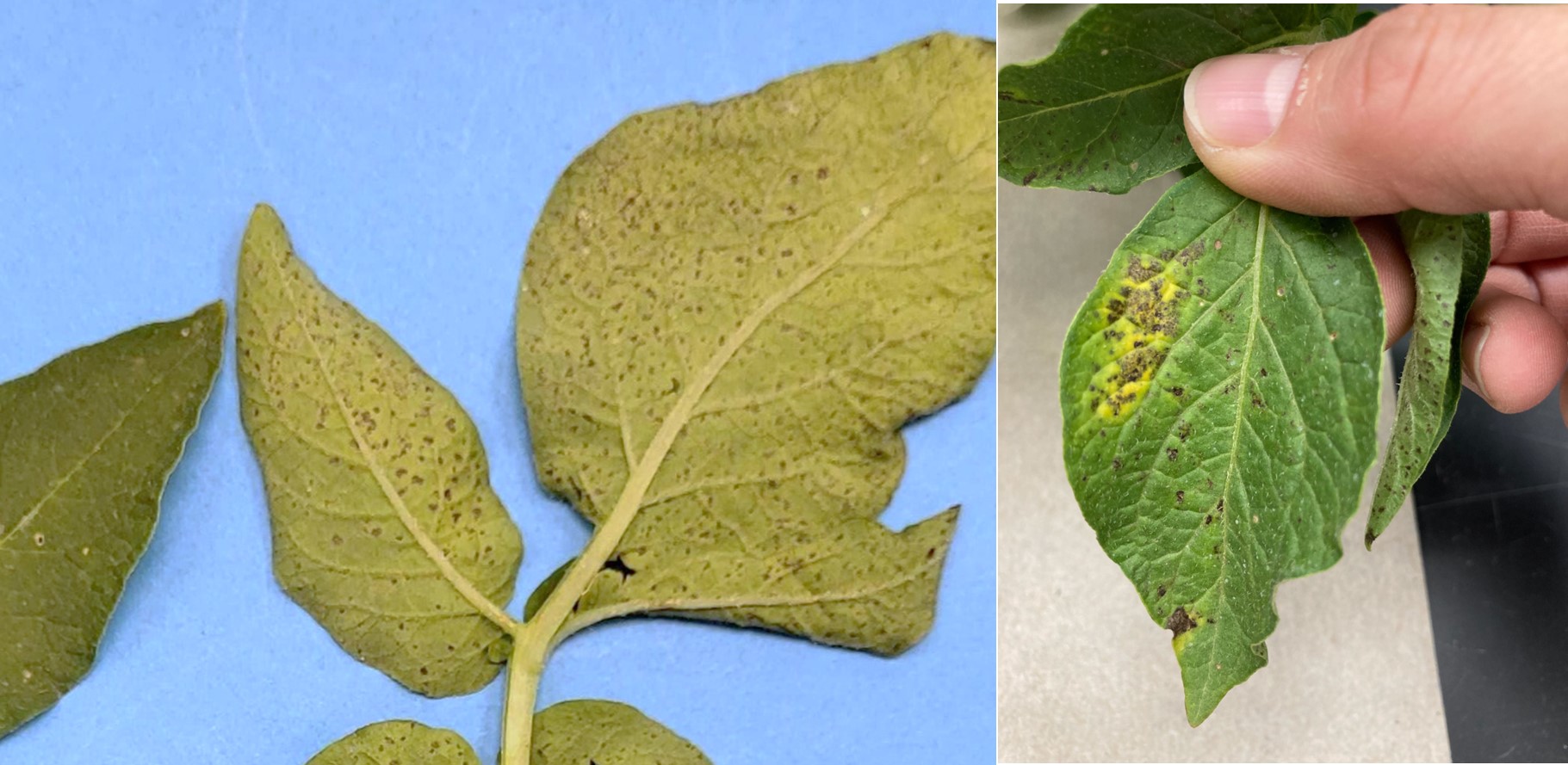
Fruiting vegetables
Driving rains early last week were strong enough to tip over unsupported plants and knock off flowers on peppers. We could see some Phytophthora flare ups in the coming week.
European corn borer trap catches in southwest Michigan are variable, ranging from 0 to the mid-teens, and corn earworm trap catches in southwest Michigan have been steady at about three per week. Without a lot of silking corn around, corn earworm may be tempted to lay eggs in fruiting vegetables for their caterpillars to feed on young peppers and tomatoes.
In the summer of 2021 tomato necrotic spot virus was detected in two unrelated Michigan fresh market tomato production fields. This was the first detection of this virus in Michigan. This virus has been previously reported in processing tomatoes in California (2008) and fresh market tomatoes in Indiana (2017). Browning, necrotic streaking, and distortion symptoms may be present on fruit, stems, and foliage. Infected fruit may have necrotic rings on the surface, are misshapen and as a result unmarketable. The symptoms could easily be confused with those caused by tomato spotted wilt virus.
Plants infected with viral pathogens can not be treated or cured. Control is based on good sanitation and removing plants that are known to be infected to prevent further spread. This virus has been shown to spread through sap, transmission through seed and thrips may also be possible. Growers and scouts should familiarize themselves with the symptoms of this virus because early detection and action can prevent further spread. Symptomatic plants can be submitted to MSU Plant & Pest Diagnostics for testing.
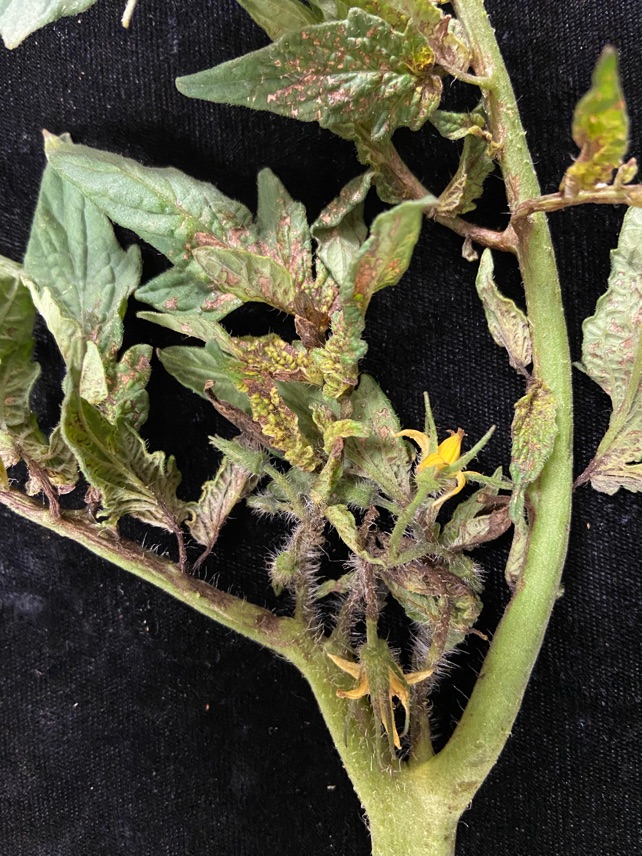
Strawberries
The latest June-bearing variety that we grow here, Malwina, is cranking out great fruit to finish out the spring strawberry season. Those who are done with harvest are beginning to renovate (click the link for herbicide tips).
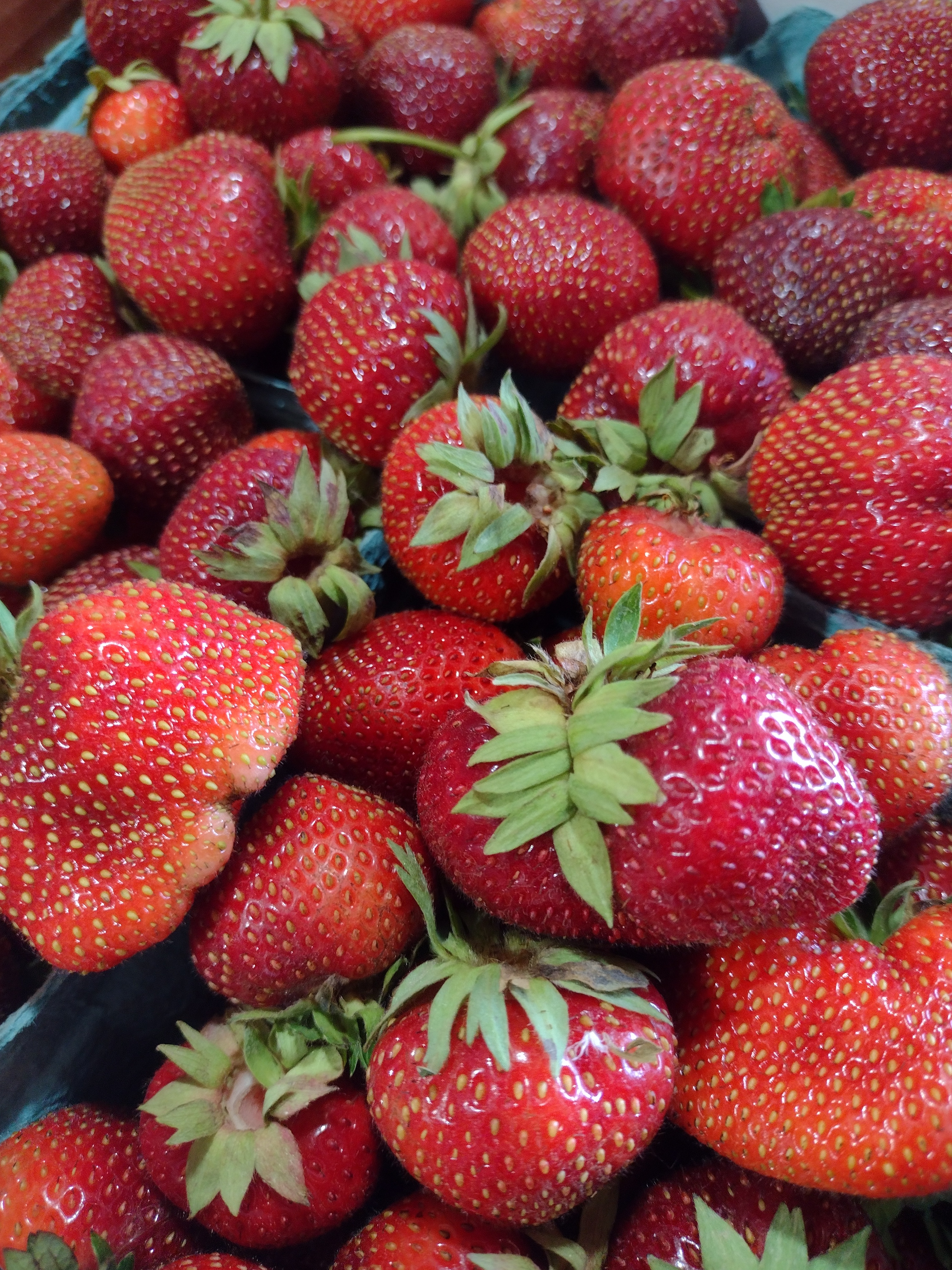
Sweet Corn
European corn borer trap catches in southwest Michigan have ranged from 0 to the mid-teens. Western bean cutworm was present in both a southwest Michigan and Oceana County trap this week. If you kick in your earworm sprays at silking, you will clean up these pests. However, European corn borer can feed in the whorl prior to tasseling. Caterpillars then move down the plant and can enter the ear once the tassel pops. A single application of a pyrethroid at tasseling can help prevent issues prior to earworm sprays.
Corn earworm was present, but at captures of < 1 per night, in a southwest Michigan and Oceana County trap. At this trap catch, a spray interval of five days should be sufficient. Pyrethroids can be effective when pressure is low. Of course, having your own trap is the best way to determine your risk, as things can vary significantly across the state. Learn more in this video tutorial on using pheromone traps to monitor corn ear worm. Insectforecast suggests little to no risk of additional corn earworm migration in the coming days.
Tar spot has started to show up in the corn belt, though it’s not been detected yet in Michigan. Last year it was confirmed from sweet corn by MSU Extension, so it is something to keep an eye out for. Keep tabs on its progress here: Corn IPM Pipe.
Events
- July 19: Dairy Open House from 4:30 to 8:30 p.m. at the K. Kellogg Biological Station. The station is located at 3700 East Gull Lake Drive in Hickory Corners. Attendees can sample MSU ice cream, while participating in family friendly activities. Guests can also participate in a guided tour of the barn and learn about Michigan's agricultural landscapes. For more information, contact the station via email at pasture.dairy@kbs.msu.edu or call 269-671-2402.
- July 27: Viticulture Field Day at the Southwest Michigan Research and Extension Center. The center is located at 1791 Hillandale Road in Benton Harbor.
- Aug. 4: Potato Field Day from 8 a.m. to 3 p.m. at the Montcalm Research Center. The center is located at 4629 W. McBride Road in Lakeview. Presentation topics include sustainability, irrigation and potato storage management.
- Aug. 10: Turf Field Day at the on-campus Hancock Turfgrass Research Center. The center is located at 4444 Farm Lane in Lansing.
- Aug. 11: Field Day and Pasture Walk at the Lake City Research Center. The center is located at 5401 W. Jennings Road in Lake City and works primarily in livestock management.
- Aug. 23: Plant Diagnostic Day at the Saginaw Valley Research and Extension Center. The center is located at 3775 S. Reese Road in Frankenmuth.
- Aug. 24: Blueberry field day at the Trevor Nichols Research Center. The center is located at 6237 124th Ave. in Fennville, Michigan.
- Aug. 25: 2022 Tile Drainage Field Day at 13000 Bird Lake Rd, Camden, MI.
- Sept. 8: Field Day at the Northwest Michigan Horticulture Research Center. The center is located at 6686 S. Center Highway in Traverse City and will highlight Michigan fruit advancements.
- Sept. 14: Mechanical Weed Control Field Day at the Southwest Michigan Research and Extension Center. The center is located at 1791 Hillandale Road in Benton Harbor. See https://thelandconnection.org/event/2022-mmwcfd/
This work is supported by the Crop Protection and Pest Management Program [grant no 2021-70006-35450] from the USDA National Institute of Food and Agriculture.



 Print
Print Email
Email




